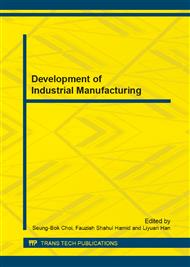[1]
S. Sharma and A. Mukherjee, Nondestructive evaluation of corrosion in varying environments using guided waves, Research in Nondestructive Evaluation, vol. 24, no. 2, (2013): 63-88.
DOI: 10.1080/09349847.2012.699609
Google Scholar
[2]
Z. P. Zheng, Y. Lei, X. P. Cui and Y. Song, Non-destructive test of the steel bar by using piezoceramics sheets, Proceeds of 3rd International conference on advanced measurement and test. Xiamen, China, March 13-14, (2013).
DOI: 10.4028/www.scientific.net/amr.718-720.692
Google Scholar
[3]
W. Na, T. Kundu and M. R. Ehsani, Ultrasonic guided waves for steel bar concrete interface testing. Material . Evaluation., vol. 60, no. 3, (2002): 437–444.
Google Scholar
[4]
W. Na, T. Kundu and M. R. Ehsani, Lamb waves for detecting delamination between steel bars and concrete. Computer-Aided Civil and Infrastructure Engineering, vol. 18, no. 1, (2003): 58–63.
DOI: 10.1111/1467-8667.t01-1-00299
Google Scholar
[5]
W. Na, T. Kundu and M. R. Ehsani, A comparison of steel/concrete and glass fiber reinforced polymers/concrete interface testing by guided waves, Material Evaluation, vol. 61, (2003): 155–161.
Google Scholar
[6]
H. Reis, B . L. Ervin, D. A. Kuchma and J .T. Bernhard, Estimation of corrosion damage in steel reinforced mortar using guided waves, Pressure Vessel Technology, vol. 127, (2005): 255–261.
DOI: 10.1115/1.1989352
Google Scholar
[7]
F. Wu, and F. K. Chang, Debond detection using embedded piezoelectric elements in reinforced concrete structures. -part I: Experiment. Structural Health Monitoring, vol. 5, (2006): 5–15.
DOI: 10.1177/1475921706057978
Google Scholar
[8]
F. Wu, and F. K. Chang, Debond detection using embedded piezoelectric elements in reinforced concrete structures. Part II: Analysis and Algorithm, Structural Health Monitoring, vol. 5, (2006): 17–28.
DOI: 10.1177/1475921706057979
Google Scholar
[9]
C. He, J. K. Van Velsor, C. M. Lee and J. L. Rose, Health monitoring of rock bolts using ultrasonic guided waves, quantitative nondestructive evaluation. Proceedings of AIP Conference. 820, AIP, Reston, Va., (2006): 195–201.
DOI: 10.1063/1.2184529
Google Scholar
[10]
B. L. Ervin, and H. Reis, Longitudinal guided waves for monitoring corrosion in reinforced mortar. Measurement. Science and Technology, vol. 19, no. 1, (2008): 1–19.
DOI: 10.1088/0957-0233/19/5/055702
Google Scholar
[11]
B. L. Ervin, D. A. Kuchma, J. T. Bernhard and H . Reis, Monitoring corrosion of rebar embedded in mortar using high frequency guided ultrasonic waves, Engineering Mechanics, vol. 135, no. 1, (2009): 9–19.
DOI: 10.1061/(asce)0733-9399(2009)135:1(9)
Google Scholar
[12]
S. Sharma and A. Mukherjee, Longitudinal guided waves for monitoring chloride corrosion in reinforcing bars in concrete. Strucural Health Monioring., vol. 9, (2010): 555–567.
DOI: 10.1177/1475921710365415
Google Scholar
[13]
B. Pavlakovic, M. Lowe and P. Cawley, High frequency low loss ultrasonic modes in imbedded bars. Applied . Mechanics, vol. 68, (2001): 67–75.
DOI: 10.1115/1.1347995
Google Scholar
[14]
F. Di Scalea, P. Rizzo and F. Seible, Stress measurement and defect detection in steel strands by guided stress waves. Material in Civil Engineering, vol. 15, no. 3, (2003): 219–227.
DOI: 10.1061/(asce)0899-1561(2003)15:3(219)
Google Scholar
[15]
T. Miller, C. J. Hauser and T. Kundu, Nondestructive inspection of corrosion and delamination at the concrete-steel reinforcement interface. Proceedings of ASME NDE Division, Symposium, New Orleans, vol. 23, (2002): 121–128.
DOI: 10.1115/imece2002-33493
Google Scholar
[16]
S. Sharma and A. Mukherjee, Monitoring corrosion in oxide and chloride environments using ultrasonic guided waves, Material in Civil Engineering, vol. 23, no. 2, (2011): 207–211.
DOI: 10.1061/(asce)mt.1943-5533.0000144
Google Scholar
[17]
B .L. Ervin, J. T. Bernhard, D. A. Kuchma, et al. Estimation of corrosion damage to steel reinforced mortar using frequency sweeps of guided mechanical waves, Proceedings of SPIE, San Diego, CA, vol. 6174, (2006): 61749H 1-12.
DOI: 10.1117/12.654589
Google Scholar
[18]
B. L. Ervin, J .T. Bernhard, D. A. Kuchma and H. Reis, Estimation of general corrosion damage to steel reinforced mortar using frequency sweeps of guided mechanical waves. Insight, vol. 48, no. 11, (2006): 682–692.
DOI: 10.1784/insi.2006.48.11.682
Google Scholar


